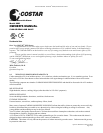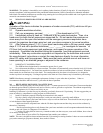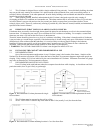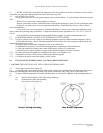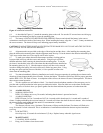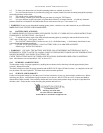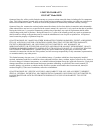
Instruction Manual: COSTAR
®
9SIR, Residential CO Alarm
QGI P/N 099-0057-01 REV 10/26/01
Page 2 of 7
WARNING: This product is intended for use in ordinary indoor locations of family living units. It is not designed to
measure compliance with Occupational Safety and Health Administration (OSHA) commercial or industrial standards.
Individuals with medical problems may consider using warning devices which provide audible and visual signals for carbon
monoxide concentrations under 30 ppm.
2.0 WHAT YOU SHOULD DO IF THE ALARM SOUNDS
WARNING:
Activation of this device indicates the presence of carbon monoxide (CO), which can kill you.
If alarm sounds:
2.1 Operate reset/silence button;
2.2 Call your emergency services (____ - ______) [fire department or 911];
2.3 Immediately move to fresh air – outdoors or by an open door/window. Then, do a
head count to check that all persons are accounted for. Do not reenter the premises nor
move away from the open door/window until the emergency services responders have
arrived, the premises have been aired out, and your alarm remains in its normal condition.
2.4 After following steps 2.1-2.3, if your alarm reactivates within a 24-hour period, repeat
steps 2.1-2.3 and call a qualified technician (____ - ______) to investigate for sources of
CO from fuel burning equipment and appliances, and inspect for proper operation of this
equipment. If problems are identified during this inspection, have the equipment serviced
immediately. Note any combustion equipment not inspected by the technician and consult
the manufacturers' instructions or contact the manufacturers directly for more information
about CO safety and this equipment. Make sure that motor vehicles are not and have not
been operating in an attached garage or adjacent to the residence.
2.5 IMPORTANT CONSIDERATIONS
The 9SIR has been designed and is warranted to operate for six years.
2.6 Never disconnect the battery to silence an alarm. The alarm will automatically sense when the level of CO in the
air falls below the danger level. You should stay outside the residence in fresh air until the alarm is silenced. When the
alarm sounds, do not stand too close to the alarm. The sound produced by the alarm is loud because it is designed to
awaken a person in an emergency. Prolonged exposure to the alarm at a close distance may be harmful to your hearing.
NOTE: Manufacturer strongly recommends replacement of alarm six years after date of purchase. Under no
circumstances should the alarm be used (7) years after the date of purchase.
3.0 DEVELOPING YOUR OWN CO SAFETY PLAN
This CO alarm can quickly alert you to the presence of CO — it cannot prevent toxic CO emissions. Please note that there
are hazards against which CO detection may not be effective, such as gas leaks or explosions. The ultimate responsibility
for protection against toxic CO fumes rests solely on you.
Installing CO detectors is just the first step in protecting your family from toxic CO poisoning. We also suggest that you
create an effective, comprehensive safety program as outlined below.
3.1 Install CO detectors properly following the instructions in this manual.
3.2 Develop a family escape plan and practice it with your entire family, especially small children.
– Draw a floor plan of your home and find two ways to exit from each room. There should be one way to get out
of each bedroom without opening the door.
– Make sure that all occupants know what the CO alarm signal means and how they must exit the residence by
themselves if necessary.
– Decide on a meeting place a safe distance from your house and make sure all occupants understand where they
should go and wait if there is a dangerous CO condition.
– Conduct CO safety drills at least every 6 months to make sure that everyone, even small children, know what to
do in order to escape safely.
– Know where to go to call the Fire Department from outside your residence.
NOTE: This unit is designed to detect carbon monoxide (CO) entering its sensing chamber. It does not sense combustible
gas (such as natural gas, propane or butane), heat, smoke or flames.



